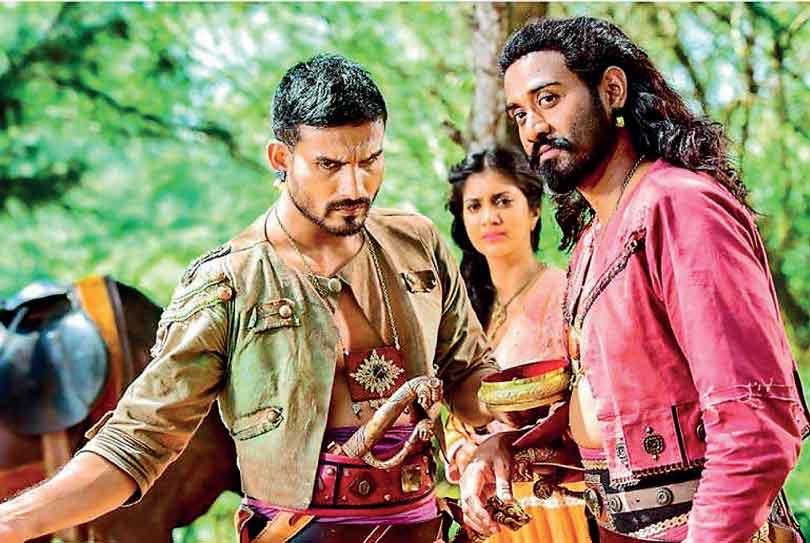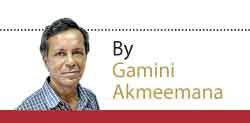Reply To:
Name - Reply Comment

 So glad someone did it at last. W. A. Silva’s Vijayaba Kollaya should have been filmed long ago, but no one did. The film’s brochure quotes Dr Lester James Pieris as saying Vijayaba Kollaya cannot be filmed, which is nonsense.
So glad someone did it at last. W. A. Silva’s Vijayaba Kollaya should have been filmed long ago, but no one did. The film’s brochure quotes Dr Lester James Pieris as saying Vijayaba Kollaya cannot be filmed, which is nonsense.
It has all the ingredients of a great film romance – heroes and villains, a love triangle, intrigue, betrayal, chivalry, battles and sword fights.
Perhaps Lester was discouraged after his experience with God-King. Give credit where it is due – Dr Sunil Ariyaratne is not one to give up easily. After a prolific career as a filmmaker (Though I found many of his films to be boring), he has given us in Vijayaba Kollaya an entertaining movie which holds our attention from beginning to end without slack, which reinforces my thesis that it’s never too late for anyone to learn.
What more do you want? This is a pertinent question since there were about thirty people in the Ritz Cinema auditorium on Sunday evening for the 6.30 p.m. screening (This was the opening week).
Our serious filmmakers are blamed for making ‘festival’ films which drive audiences away in droves. Sunil Ariyaratne has made Vijayaba Kollaya in the Hindi commercial format, and it’s quite well made though with a number of problems which detract from this movie’s overall excellence. Nonetheless, it’s worth seeing.
Vijayaba Kollaya might have been a box office hit if Asanga had hired Kotte thugs to throw some acid on Nilamani and to murder Nayanananda and make it look like an accident
I have seen crowds, including moms carrying toddlers and grandmothers, lining up to see trashy comedies at the same venue. The conclusion is that there is something chronically wrong with our audiences.
This has become a country where people watch movies in DVD format, which is a problem of vision. An epic needs a wide screen.
W. A. Silva wrote entertaining novels. He wrote love stories, satires, adventures and even one detective novel (Still the best one we have) and he remained unsurpassed in the historical romance genre.
Martin Wickremasinghe wrote one–Rohini, set against the Dutugemunu-Elara context – and it’s a good novel though everyone seems to have forgotten it. But Rohini doesn’t quite match up to the kind of electricity that W. A. Silva generates through his prose and characterisation.
Martin Wickremasinghe sounds staid when describing young love. W. A. Silva revels in it, and his ability to evoke erotic passion with descriptions not of sex (Taboo in that era) but simply writing about what happens to a woman’s face when she feels love at the sight of a man remains unsurpassed in the annals of Sinhala fiction. W. A. Silva was influenced in the historical adventure-romance genre by writers such as R. D. Blackmore (Lorna Doone) and H. Rider Haggard (King Solomon’s Mines, The Return of She), and works such as Vijayaba Kollaya and Sunethra are on par with any of those classics in their writing power. That’s why W. A. Silva’s books live on.
The director manages to bring alive that shimmering quality which W. A. Silva bestowed on his characters and dramatic situations using his narrative powers. Undoubtedly, this has much to do with the late Tissa Abeysekara’s script. He has simplified it to fit the movie format.
The song-dance sequences are excellent, though the musical score is obtrusive, taking us back to the time when the violins struck up whenever the tension mounted, the difference being that electronic music has replaced the violins.
We are treated to 16th century Kotte fashions showing Portuguese influence, though one doubts if Portuguese women wore knee-length frocks even in Portugal at the time.
The scriptwriter/director team has largely left out the author’s own version of the politics of the Kotte era – a Sinhala-Muslim alliance against the Portuguese, while the Tamils are seen as unfriendly and unreliable.
The Nayakkar soldiers on the payroll of Kotte are shown in a bad light, though it isn’t certain if there was a Nayakkar military factor as far back as the 16th century.
W. A. Silva had a flair for irony and comedy. In the novel, while the Portuguese pillage Colombo and suburbs in a surprise nocturnal raid, the commander-in-chief’s wife Vindunatha and daughter Nilamani start packing their jewellery despite his urgent cries.
This is a gem of a scene which has been left out. Other chops include more comedy such as Father Coutinho, a refugee in Kotte in the custody of the Buddhist clergy, infuriating them with his theological arguments, or the moment when Nayananda brings Vindunatha and a group of court ladies grave news that the king’s three sons have escaped custody, and they calmly go on with their business of buying clay pots.
It’s a pity that such scenes, which need not be lengthy, have been left out.
The romance between Prince Mayadunne and his fiancée Leelavathi too has been left out, though it could have added much flavour to the script. These omissions do not make sense given what has been added to the story – a Buddhist monk who plays kingmaker.
In the novel, the three princes take refuge with a Buddhist monk after their escape. But this is incidental and we don’t meet him as a character in the book.
W. A. Silva doesn’t promote religion either for the sake of piety or politics, and he is scathing in his opinion of the clergy of Kotte. Hence, this addition to the script is a deliberate attempt to bring the story in line with contemporary politics. The filmmaker is imposing his politics on us.
The movie is visually very pleasing. That the director has followed the Bollywood epic format is not a criticism. What other format are we to take? The Bollywood format differs from the Hollywood one mainly in singing and dancing.
Acting styles, camera techniques and special effects are otherwise very similar. Hollywood uses a catchy theme song or music (The Gladiator, The Last of the Mohicans) which is repeated at key moments throughout the movie, with no song-dance sequences.
This movie’s interiors (especially the tents) recall the style of Sanjay Leela Bansali, dubbed the great stylist of Indian cinema. It’s heartening to see the kind of attention paid to detail, though there are a few slips here and there (for example in the ‘baila dance’ sequence where a modern violin and acoustic guitar are used). The movie’s casting is spot-on for the most part.
The acting is not only excellent but the screen characters bring alive with great fidelity the novel’s protagonists – Hemal Ranasinghe as the conscientious spy-warrior Nayanananda, Ashan Dias as Asanga, the noble deputy general of Kotte, Senali Fonseka as Neelamani, the Kotte general’s impulsive daughter, Hans Bilimoria as the mercenary Portuguese captain General De Lazerda (possibly modeled after the notorious Jeronimo de Azavedo), Chulakshi Ranatunga as Hamidduma, De Lazerda’s beautiful captive, Sunil Costa as the humane Franciscan friar Coutinho, Dr. Ariyaratne Kaluarachchi as King Vijayaba, Erdley Vedamuni as the commander in chief of Kotte forces, Buddhika Jayaratne as Kandure Bandara, Preethi Randeniya as the general’s wife Vindunatha, Gayana Sudarshani as the fortune teller and Marion Wettasinghe as the king’s scheming consort Rupa.
Hemal Ranasinghe plays Nayananda with great flair but he obviously hasn’t studied the character. According to W. A. Silva, Nayananda is shrewder than Asanga, and a greater warrior, but he is ethical, conscientious and has a fine sensibility which doesn’t show on Hemal’s face with that piratical sneer, which doesn’t make him look as if he can be trusted.
As for the combat scenes, the individual fights (between Asanga and Nayanananda, though they don’t fight each other in the book) are good but the battle scenes are ineffectual.
Also, it’s hard to understand why the final combat between Asanga and De Lazerda begins as a fistfight unless the director was paying homage to the late Gamini Fonseka.
As for the mass battle scenes, the armies don’t look big enough. This is every Sri Lankan director’s nightmare when he starts making an epic. Another problem is that firearms, the decisive element which gave the Portuguese such an advantage, are used very scantily. W. A. De Silva wrote that the Portuguese were unaware that the Kotte forces were equipped with locally-made muskets and gunpowder, and this was a key element in their victory.
I counted three muskets being fired, and you don’t see a single canon. When these muskets are fired, it looks as if the gunpowder was wet. To see the firepower of these old weapons, check out something like the Last of the Mohicans.
This is obviously a case of having to economise. The film’s budget of Rs. 70 million may seem huge to us, but it is still peanuts even by Indian standards. I’m not criticizing here, just telling the way things are. This is a huge budget for a Sri Lankan movie. Producers take huge risks investing such amounts, and when audiences don’t respond, this leads to a real crisis. Who’s going to invest in the next epic? They would rather invest in real estate.
Also, key elements of epic cinema such as neighing and galloping horses too, are absent here. The horses are either stationary or at a trot, undoubtedly due to budget considerations. Notwithstanding, a good action film director (one may recall Kurosawa) would have made the battle scenes more convincing even with a relatively small number of actors (Such as in Seven Samurai) with clever camera movements and zoom shots. Unfortunately, this director does not show that flair.
There is also a nod to the phenomenon of empowered women in contemporary action cinema. Nilamani wrestles a gun from a Portuguese soldier and Hamidumma fells another with bow and arrow. That is positive thinking.
Finally, you wonder if the audience can’t connect with this story because the two heroes are noble characters with shining qualities. Though Nayanananda doesn’t miss the opportunity to grab Nilamani, he genuinely regrets the pain he caused Asanga.
Asanga, when he realises that his fiancée loves another man, nobly gives in to her wishes. When he has the chance to murder De Lazerda in his bed, he chooses to wake up his enemy and fight, with fatal consequences to himself.
Surely such chivalry and nobility of character are too good to be true in this day and age when a murder by any means in politically correct, and to wish your ex- good luck when jilted would look like mental instability.
Vijayaba Kollaya might have been a box office hit if Asanga had hired Kotte thugs to throw some acid on Nilamani and to murder Nayanananda and make it look like an accident.